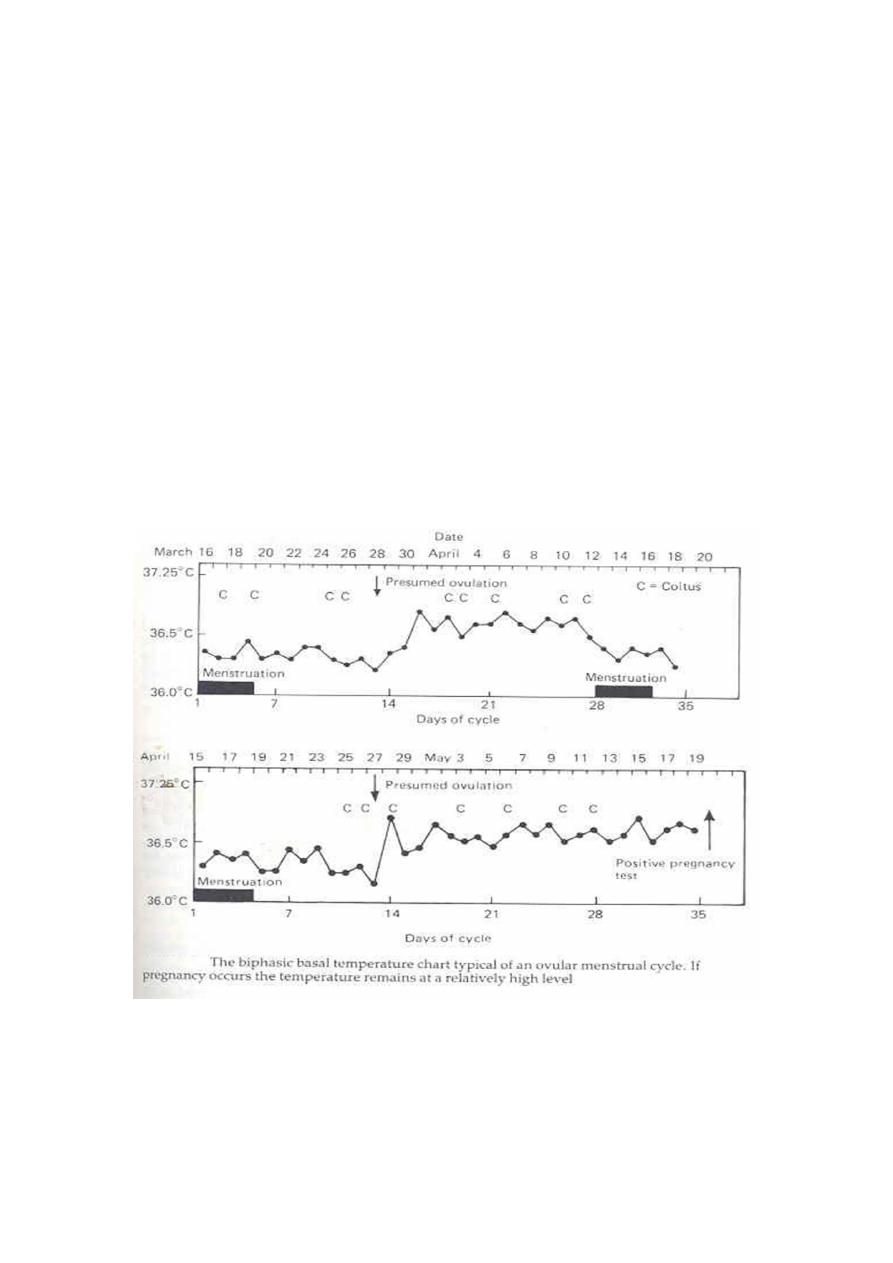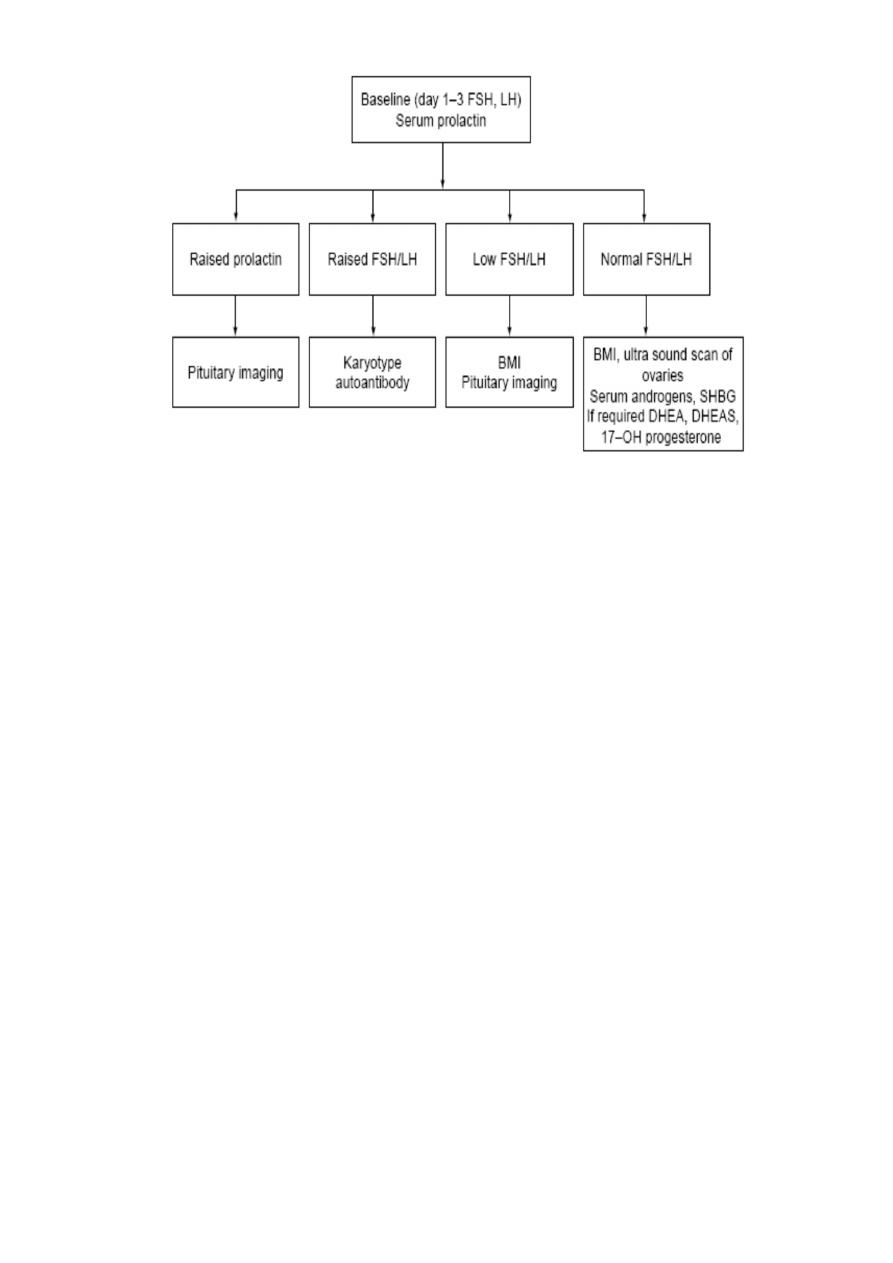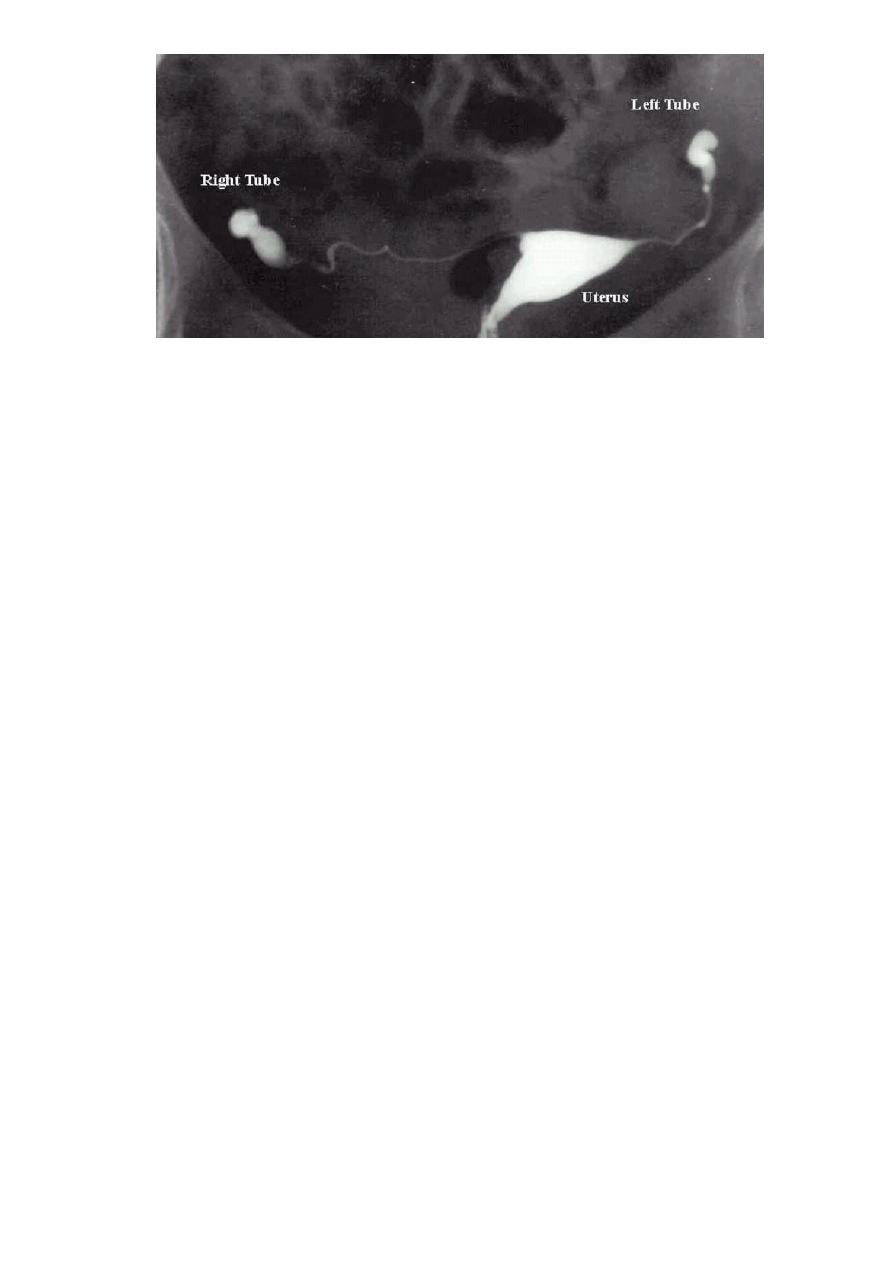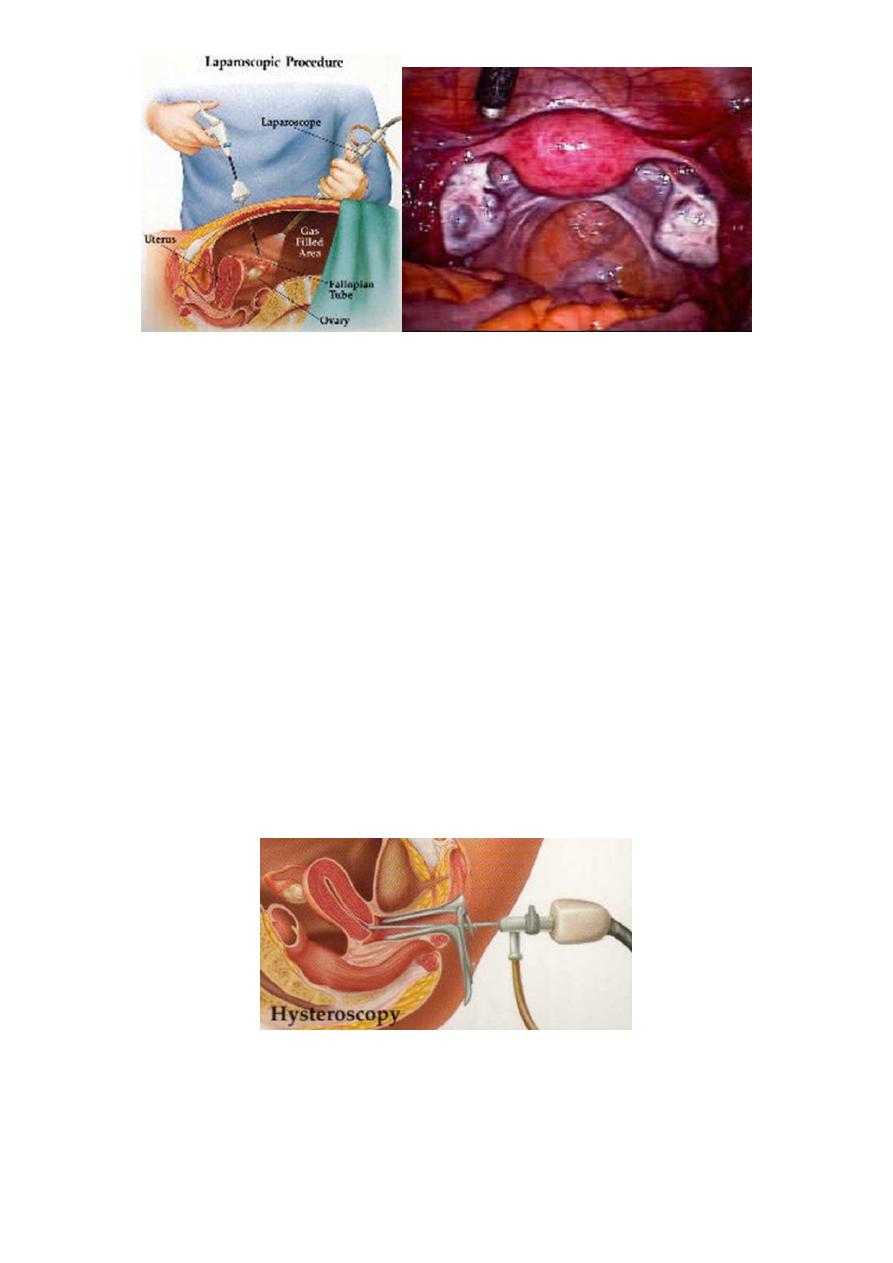
1
Fifth stage
Gynecology
Lec-
Dr.Ahmed
20/3/2017
Infertility
Examination:
Full general examination :
physical development, Sign of chromosomal abnormality, evidence of endocrine
disorder, body mass index (BMI).
Signs of hyperandrogenism (e.g., hirsutism, acne, clitoromegaly).
Carefully evaluate the thyroid gland to exclude gland enlargement or thyroid
nodules.
Breast examination to evaluate breast development and galactorrhoea.
Abdominal examination: scars, tenderness, masses.
Pelvic examination: genital development ,State of introitus, any discharge, any
tenderness, size and mobility of uterus, enlargement of ovaries.
Investigations of female :
The aim of these investigations is to assess ovulation, tubal patency and uterine factors.
Tests for ovulation:
A history of regular periods usually indicates ovulation (not always).
Most of the initial investigations for ovulatory disorder must be undertaken at
specific stages of the menstrual cycle.
1. Mid-luteal phase is approximately 7 days before the next expected period, i.e. day 21 and
day 28 in 28-day and 35-day cycles respectively. it is a reliable, safe and inexpensive test.
Levels in excess of 30nmol/L are diagnostic of ovulation. Lower level may be due to
incorrect timing of blood sampling or may be caused by a luteinized unruptured follicle.
2. ultrasound examination:
Vaginal ultrasound can be used to demonstrate the development of a follicle within
the ovary (Follicular tracking by ultrasound).
Detailed ultrasound scan performed between days 10-12 will establish follicular and
endometrial maturity. The endometrium reflects the local and systemic action of

2
reproductive steroid hormones measuring up to 8-10 mm in late follicular phase.
measuring up to 14 mm in the mid-luteal phase.
Dominant follicle can be seen and its daily increase in size (about 2 mm/ day). A
sudden reduction in size around the expected mid-cycle (from about 20-25 mm) is
suggestive of rupture of dominant follicle and release of oocyte occurred.
Confirmation of ovulation can only be established with serial scans.
Failure of oocyte release known as lutinized unruptured follicle syndrome. It may be
treatable by administration of human chorionic gonadotrophin at the right time to
mimic LH surge.
3. basal body temperature.
Women take her basal body temperature each day with special thermometer and
write it down on a chart. Immediately before ovulation, the temperature drops
briefly. Within 12 hours of ovulation the BBT rises slightly, of about 0.5° c due to
progestron secretion and this is fertile period in which intercourse encouraged.
4. LH detection kits:
serial measurement of urinary luteinizing hormone using home prediction kit. A
system of hormone monitoring designed to better define the fertile period involves
placement of disposable test sticks in a small battery powered device to detect
urinary estrone-3 glucuronide and LH. This device (Persona) can serves as both an aid
to fertility and a form of contraception

3
5. Change in cervical mucus:
Dominant follicle release estrogen and cause a profound transient change in cervical
mucus. Mucus become more copious, less viscous in consistency, increase in
stringiness (spinnbarkheit) and become a cellular with decrease in cross-linking of
mucine molecules. Once ovulation has occurred and progesterone level rise mucus
become scanty, viscid and cellular.
There is no justification for routine assessment of FSH, LH, prolactin and thyroid
function in ovulatory women.
Test for anovulation:
1
. assess ovarian reserve (women older than 35 years) by:
measurement of FSH and estradiol levels on (day 1-3) of the menstrual cycle.
clomiphene citrate (Clomid) challenge test,
transvaginal ultrasonography for antral follicle count
2. Prolactin level.(level > 1000µu/L are significant and needs CT scan of pituitary fossa).
3. Thyroid function test.
There is no value in measuring thyroid function or prolactin in women with a regular
menstrual cycle, in the absence of galactorrhoea or symptoms of thyroid disease .
4. testosterone (if hyperandrogenism suspected).
5. 17alpha-hydroxyprogesterone (if hyperandrogenism suspected),

4
Tubal patency tests:
Once preliminary investigations suggest that a woman is ovulating and semen parameters
are satisfactory, the next step should be assessment of tubal status. It can be assessed by
three different methods:
a. Hystrosalpingography
b. laproscopy and dye hydrotubation.
c. ultrasound and dye hydrotubation.
a. Hysterosalpingogram (HSG)
o A radio-opaque contrast medium is injected through cervix into the uterus
under X- ray control to assess uterine cavity and patency of fallopian tubes by
seeing free spill into peritoneal cavity. It is usually carried out in first 10 days of
menstrual cycle in order to avoid disruption of an early pregnancy. It will cause
period-like pain.
o Test preceded by taking cervical swabs for Chlamydia in any patient before
carrying intrauterine instrumentation. Some physicians prescribe several days
of antibiotics for their patients to attempt to reduce the risk of infection after
HSG.

5
Complications with a hysterosalpingogram:
1.
allergic reaction to the dye(manifests as a rash), which is uncommon.
2. Vasovagal attack.
3. flare up of pelvic inflammatory disease( PID).
4. Pelvic infection.
5. uterine perforation (very uncommon).
b. Laparoscopy and chromotubation (Laproscopy and dye test):
It is the investigation of choice as it is able to demonstrate tubal patency
(Visualize the passage of methlene blue dye through fallopian tubes)
as well as assess the pelvis for the presence of endometriosis and adhesions.
it is indicated in:
1.Women with history of pelvic pain and inconclusive HSG.
2. Patient with history suggestive of endometriosis, previous PID or previous pelvic
surgery.
3. Abnormal result of HSG.
4. Unexplained infertility.

6
c. Ultrasound scan and hydrotubation:
Hysterosalpingo contrast sonography (HyCoSy) :
Contrast medium is slowly injected into uterine cavity under direct visualization of
ultrasound, with imaging of uterine cavity and of flow along the fallopian tubes and
avoid exposure to X-rays.
Assessment of uterus:
Transvaginal pelvic ultrasound (TVS): enables pelvic structures to be visualized and
provides more information than a bimanual examination. It can identify
endometrioma, ovarian cysts, polycystic ovaries, fibroids and hydrosalpinges.
Uterine anatomy can be visualized by Hysterosalpingography or Hysterosalpingo
contrast sonography or Hysteroscopy:
hysteroscopy is useful for diagnosis and treatment.
Postcoital test:
It provides information concerning the ability of sperm to penetrate and survive in
cervical mucus. It has high false-positive rate and it's result dose not change
treatment so it is not recommended in the routine investigation of the infertile
couple.

7
Treatment of female infertility:
1. It should begin with a description of physiology of the cycle, information about the
fertile period, life style issues, including advice on smoking.
2. discuss frequency of intercourse.
3. Correction of coital difficulties:
4. Timed intercourse was found to be the most emotionally stressful activity in the
initial infertility evaluation. Although the greatest probability of conception is in the
two days before ovulation and the day of ovulation itself, as Sperm survive in the
female reproductive tract for up to 72 hours, and an ovum can be fertilized for up
to 24 hours after ovulation. It may be counterproductive to restrict intercourse only
to this time as semen quality, measured in terms of motility and morphology,
declines with >10 days' abstinence. Regular intercourse, e.g. 2-3 times a week, should
ensure that intercourse falls within the fertile period.
5. advice to avoid any lubricant with sexual intercourse and vaginal douching after it.
6. women should be advised to lie on her back for at least 15 minutes after coitus to
prevent sudden loss of semen from vagina.
7. Further planning of treatment protocols will depend on the presumed cause of the
problem and Treatment policies must be indivualized.
8. Many factors affecting conception rates would include:
Female age's
Baseline FSH level. (greated than 10 U/L have poor prognosis)
Previous conception.
Associated sperm dysfunction.
Peak human fertility (the chance of pregnancy per menstrual cycle
in the most fertile couples) is no higher than 33%, and it is unrealistic to expect
a higher chance of pregnancy than this from any fertility treatment.
treatment of anovulatory infertility:
Select method depends on the cause of anovulation.
Normalization of body weight in underweight and obese patients can help to regain
ovulation without the need for medical intervention.

8
Ovulation induction :
1.
medical induction (Fertility drugs):
Fertility drugs are the primary treatment for women who are infertile due to
ovulation disorders. These medications regulate or induce ovulation. Before starting
therapy , the male's semen must be analyzed.
Commonly used ovulation induction drugs ( fertility drugs) include:
Clomiphene citrate (Clomid).
It is non steroidal agent with both oestrogenic and non-oestrogenic properties
stimulate the release of FSH and LH, by blocking oestradiol receptors which
result in follicle stimulation.it is taken orally usually at 50 mg daily from 2-6 of
menstrual cycle and increased up to 150 mg daily if there is no response.
Women with PCOS responds to 25mg daily from 2-6 of cycle.
It can be prescribed up to maximum of six cycles if ovulation is occurring.
Monitoring of treatment cycles with serial ultrasound scans is recommended.
Risks of treatment and side effect with clomiphene citrate:
1. Multiple pregnancy.10%
2. Ovarian hyperstimulation syndrome <1%.
3. visual disturbance.
4. thickening of cervical
5. mucus and hot flushes
6. Other side effects include abdominal distension (2%), abdominal pain, nausea,
vomiting, headache, breast tenderness and reversible hair loss.
Gonadotrophin therapy:
Used in women with Clomiphene-resistant and in Clomiphene-resistant PCOS.
It is either :
*FSH (urinary or recombinant) (Gonal-F,). subcutanouslly
*Human menopausal gonadotropin, or hMG (combination of FSH and LH derived
from postmenopausal women urine) (Pergonal). intramuscularly directly stimulate
the ovaries.
Can be given as daily dose or in alternate daily injection from early follicular phase
until follicular maturation is confirmed. Cycles monitored with serial ultrasound scans

9
Risks:
Multiple pregnancy. Up to 25%.
Ovarian hyperstimulation syndrome.
Gonadotropin-releasing hormone (GnRH) analogs.
Can treat hypothalamic anovulatory cases. Administered with an infusion pump
either subcutaneously or intravenously in a pulsataile fashion.
Letrozole (Femara).
This drug is in a class of medications called aromatase inhibitors given for women
who haven't responded to treatment with clomiphene citrate. The drug's
manufacturer has warned doctors not to use the drug for fertility purposes because
of possible adverse health effects. These adverse effects may include birth defects
and miscarriage.
Dopamine agonists:
Anovulation due to hyperprolactinaemia is effectively treated with dopamine
agonists. Bromocriptin is an ergot alkaloid with dopaminic properties.
It is administered in a daily dose of 1.25mg at bed time with a snack, and
gradually increasing up to 2.5 mg three times a day with food over 2 to 3
weeks.it causes gastrointestinal side effect and hypotension.
Cabergoline and Quinogolide are newer dopamine agonists which have
recently been used for treatment of hyperprolactinaemia. they have fewer side
effects and longer half-lives and allow a once daily dose for
quinogolide and a twice weekly dose for Cabergoline.
Metformin (Glucophage).
This oral drug is taken to boost ovulation. It's used when insulin resistance is known
or suspected.
Human chorionic gonadotropin, or hCG (Ovidrel, Pregnyl).
used in combination with clomiphene, hMG and FSH, this drug stimulates the
follicle to release its ovum (ovulate).
2. surgical induction of ovulation:
Laparoscopic ovarian drilling in women with poly cystic ovary syndrome (PCOS) .

10
Management of tubal infertility:
a
. Tubal surgery. Has a place in less severe forms of disorder.
b. In Vito Fertilization- Embryo Transfer (IVF-ET).
c. selective salpingography and tubal cannulation don at hysteroscopy useful to
treat proximal tubal damage.
Management of endometriosis-related infertility
:
(disscused in endometriosis
lecture)
Management of uterine factor infertility:
treatment should be considered if failure of implantation seems to be the only cause
of an unsuccessful IVF-ET treatment. treatment according to case.
Management of unexplained infertility:
Treatment is empirical
Conservative management
Ovulation induction with or without intrauterine insemination.
IVF-ET has diagnostic and therapeutic values as it provides information about
fertilization and egg and embryo quality.
